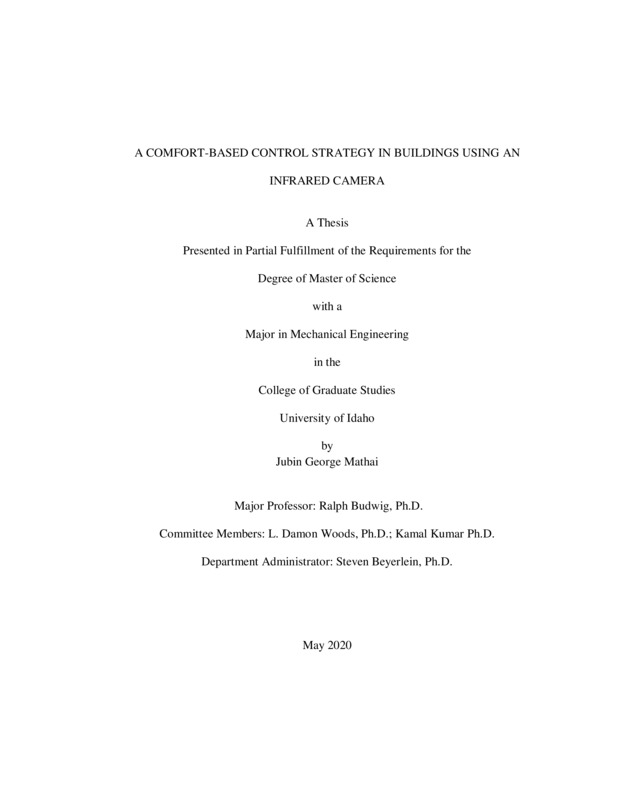A COMFORT-BASED CONTROL STRATEGY IN BUILDINGS USING AN INFRARED CAMERA
Mathai, Jubin George. (2020-05). A COMFORT-BASED CONTROL STRATEGY IN BUILDINGS USING AN INFRARED CAMERA. Theses and Dissertations Collection, University of Idaho Library Digital Collections. https://www.lib.uidaho.edu/digital/etd/items/mathai_idaho_0089n_11805.html
- Title:
- A COMFORT-BASED CONTROL STRATEGY IN BUILDINGS USING AN INFRARED CAMERA
- Author:
- Mathai, Jubin George
- ORCID:
- https://orcid.org/0000-0002-1000-3067
- Date:
- 2020-05
- Keywords:
- Building Controls Human Thermal Comfort Infrared Camera
- Program:
- Mechanical Engineering
- Subject Category:
- Mechanical engineering
- Abstract:
-
This proof-of-concept study focuses on the feasibly of using a low-cost infrared camera to determine comfort conditions indoors. There are six parameters that govern the thermal comfort of an occupant which are clothing levels, metabolic activity, air velocity, relative humidity, air temperature, and the most importantly the mean radiant temperature (MRT). Almost 40% of our thermal perception of indoor surroundings occurs through radiation. The conventional thermostat measures only air temperature as a control parameter. Several studies show that air temperature alone as a control parameter causes occupant discomfort, reduces productivity, and increases energy usage in buildings. The main energy driver in buildings is thermal comfort. In this study, a comfort-based control strategy was developed based on Fanger’s Predicted Mean Vote (PMV) method. The infrared camera’s surface temperature readings were validated with thermocouple measurements and were found to be in the range of +1.23°F. We developed a spreadsheet tool in Excel to determine MRT and PMV values which agreed with the Center of Built Environment’s thermal comfort tools. Infrared images combined with machine learning techniques performed occupant detection. Energy models were used to predict energy savings and uncomfortable hours in three different climate zones in the United States with a PMV based control in comparison to conventional control. The simulation results indicated that the PMV based control maintained thermal comfort across all the locations, significantly lowered the overcooling issues dominant in conventional control, and had energy-savings at the Tampa, Florida location.
- Description:
- masters, M.S., Mechanical Engineering -- University of Idaho - College of Graduate Studies, 2020-05
- Major Professor:
- Budwig, Ralph
- Committee:
- Woods, Lindsay Damon; Kumar, Kamal
- Defense Date:
- 2020-05
- Identifier:
- Mathai_idaho_0089N_11805
- Type:
- Text
- Format Original:
- Format:
- application/pdf
- Rights:
- In Copyright - Educational Use Permitted. For more information, please contact University of Idaho Library Special Collections and Archives Department at libspec@uidaho.edu.
- Standardized Rights:
- http://rightsstatements.org/vocab/InC-EDU/1.0/

